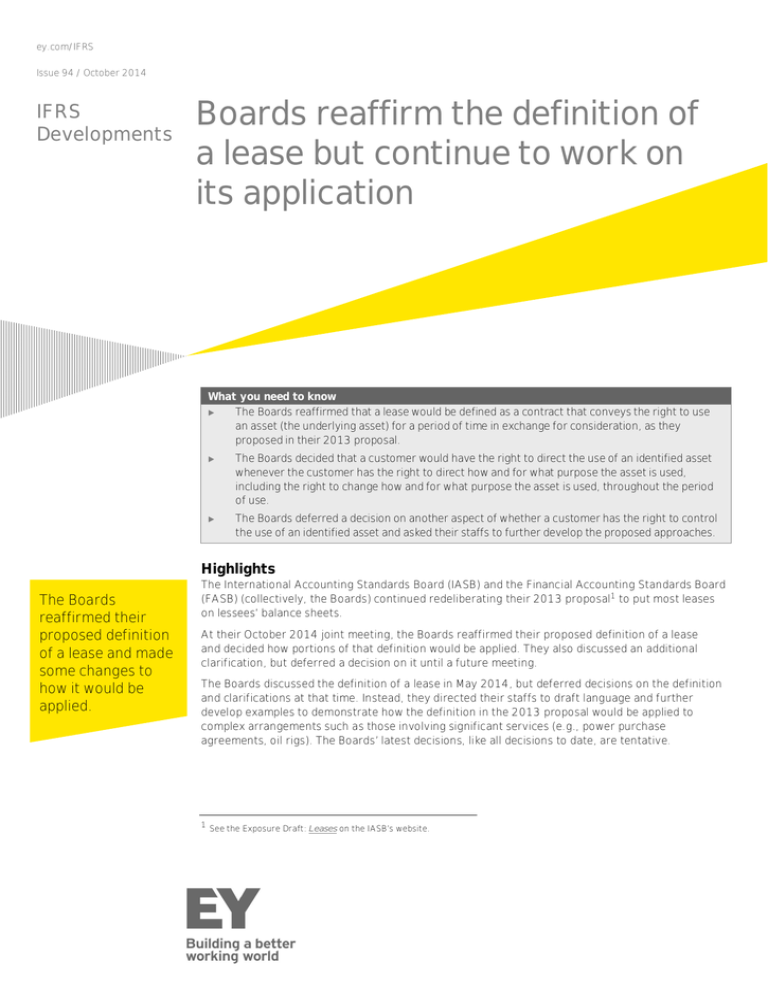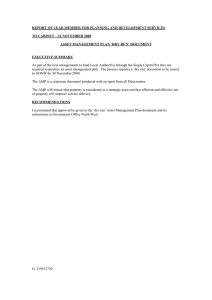
ey.com/IFRS
Issue 94 / October 2014
IFRS
Developments
Boards reaffirm the definition of
a lease but continue to work on
its application
What you need to know
u
The Boards reaffirmed that a lease would be defined as a contract that conveys the right to use
an asset (the underlying asset) for a period of time in exchange for consideration, as they
proposed in their 2013 proposal.
u
u
The Boards decided that a customer would have the right to direct the use of an identified asset
whenever the customer has the right to direct how and for what purpose the asset is used,
including the right to change how and for what purpose the asset is used, throughout the period
of use.
The Boards deferred a decision on another aspect of whether a customer has the right to control
the use of an identified asset and asked their staffs to further develop the proposed approaches.
Highlights
The Boards
reaffirmed their
proposed definition
of a lease and made
some changes to
how it would be
applied.
The International Accounting Standards Board (IASB) and the Financial Accounting Standards Board
(FASB) (collectively, the Boards) continued redeliberating their 2013 proposal1 to put most leases
on lessees’ balance sheets.
At their October 2014 joint meeting, the Boards reaffirmed their proposed definition of a lease
and decided how portions of that definition would be applied. They also discussed an additional
clarification, but deferred a decision on it until a future meeting.
The Boards discussed the definition of a lease in May 2014, but deferred decisions on the definition
and clarifications at that time. Instead, they directed their staffs to draft language and further
develop examples to demonstrate how the definition in the 2013 proposal would be applied to
complex arrangements such as those involving significant services (e.g., power purchase
agreements, oil rigs). The Boards’ latest decisions, like all decisions to date, are tentative.
1
See the Exposure Draft: Leases on the IASB’s website.
Key decisions
The Boards reaffirmed that a lease would be defined as a contract that conveys the
right to use an asset (the underlying asset) for a period of time in exchange for
consideration. This definition is consistent with their 2013 proposal. Under this
definition, entities would determine whether a contract contains a lease by assessing
whether:
u
u
The use of an identified asset is either explicitly or implicitly specified
The contract conveys to the customer the right to control the use of the identified
asset throughout the period of use
The Boards also reaffirmed that a contract would not involve the use of an identified
asset if a supplier has the substantive right to substitute the asset used to fulfil the
contract. The Boards decided that a substitution right would be substantive if the
supplier has the practical ability to substitute the asset and can benefit from exercising
that right.
A customer would have
the right to direct the use
of an identified asset
when it can determine
how and for what purpose
the asset is used.
Further, the Boards agreed that a contract conveys the right to control the use of an
identified asset if, throughout the period of use, the customer has the right to direct
the use of the identified asset and obtain substantially all of the economic benefits
from directing the use of the identified asset.
At this meeting, the Boards agreed on how an entity would determine whether the
customer has the right to direct the use of the identified asset. The Boards explored
but deferred decisions on whether a contract would contain a lease only when the
customer has the ability to derive the benefits from directing the use of an identified
asset on its own or together with other readily available resources.
Right to direct the use of an identified asset
The Boards decided that a customer has the right to direct the use of an identified
asset whenever it has the right to direct how and for what purpose the asset is used,
including the right to change how and for what purpose the asset is used, throughout
the period of use. The Boards believe that, in most circumstances, these are the
decisions that most significantly affect the economic benefits that can be derived
from the use of the underlying asset.
If neither the customer nor the supplier controls how and for what purpose the asset is
used throughout the period of use (e.g., when how and for what purpose the asset can
be used are predetermined in the contract), the Boards decided the customer would
have the right to direct the use of the identified asset in either of the following
circumstances:
u
u
The customer has the right to operate the asset or direct others to operate the asset
in a manner that it determines (with the supplier having no right to change those
operating instructions)
The customer designed the asset, or caused it to be designed, in a way that
predetermines how and for what purpose the asset will be used or how it will be
operated
The Boards also decided that a supplier’s protective rights, in isolation, would not
prevent the customer from having the right to direct the use of an identified asset.
However, the Boards believe that protective rights typically define the scope of the
customer’s use of the asset. Protective rights are intended to protect a supplier’s
interests (e.g., interests in the asset, its personnel, compliance with laws and
regulations) and might take the form of a specified maximum amount of asset use
or a requirement to follow specific operating instructions.
2
Boards reaffirm the definition of a lease, but continue to work on its application
EY | Assurance | Tax | Transactions | Advisory
How we see it
u
u
Until the Boards complete their redeliberations on issues related to the definition of a
lease, it is not clear how their decisions on a customer’s ’right to direct the use of an
asset’ would be applied.
In addition, we still have questions related to how the Boards’ definition would be
applied to a contractual arrangement when significant services are included and the
major terms of those services have been predetermined. That is, does the customer
have the right to control the use of the identified asset when virtually all of the
operating decisions have been predetermined? It is also unclear to us what decisions
come into play in making the assessment.
Other discussion topics
Derive the benefits from directing the use of an identified asset
The Boards discussed clarifying how the economic benefits portion of the definition
of a lease would be applied, including whether a contract would contain a lease only
when the customer has the ability to derive the benefits from directing the use of an
identified asset on its own or together with other readily available resources. The
Boards instructed their staffs to consider feedback from Board members and to bring
the issue back to a future Board meeting.
Next steps
Before drafting a standard, the Boards need to complete their redeliberations on the
definition of a lease and address several remaining issues, including the IASB’s
recognition and measurement exemption for leases of small assets, lessee disclosures,
transition, effective date and consequential amendments to other standards. The
FASB will also separately discuss not-for-profit issues. A standard is not expected
before the third quarter of 2015.
About EY
EY is a global leader in assurance, tax,
transaction and advisory services. The insights
and quality services we deliver help build trust
and confidence in the capital markets and in
economies the world over. We develop
outstanding leaders who team to deliver on
our promises to all of our stakeholders. In so
doing, we play a critical role in building a
better working world for our people, for our
clients and for our communities.
EY refers to the global organization and may
refer to one or more of the member firms of
Ernst & Young Global Limited, each of which is
a separate legal entity. Ernst & Young Global
Limited, a UK company limited by guarantee,
does not provide services to clients. For more
information about our organization, please
visit ey.com.
About EY’s International Financial Reporting
Standards Group
A global set of accounting standards provides
the global economy with one measure to
assess and compare the performance of
companies. For companies applying or
transitioning to International Financial
Reporting Standards (IFRS), authoritative and
timely guidance is essential as the standards
continue to change. The impact stretches
beyond accounting and reporting, to key
business decisions you make. We have
developed extensive global resources — people
and knowledge — to support our clients
applying IFRS and to help our client teams.
Because we understand that you need a
tailored service as much as consistent
methodologies, we work to give you the
benefit of our deep subject matter knowledge,
our broad sector experience and the latest
insights from our work worldwide.
© 2014 EYGM Limited.
All Rights Reserved.
EYG No. AU2693
ED None
In line with EY’s commitment to minimize its impact on the
environment, this document has been printed on paper
with a high recycled content.
This material has been prepared for general informational
purposes only and is not intended to be relied upon as
accounting, tax, or other professional advice. Please refer
to your advisors for specific advice.
ey.com


